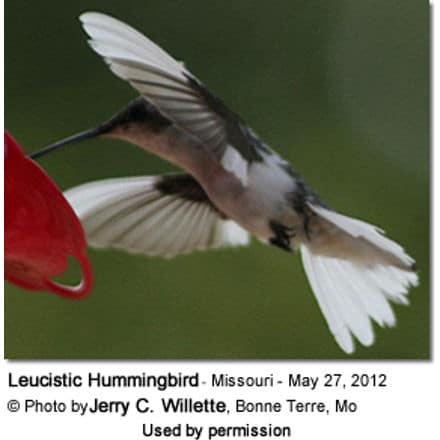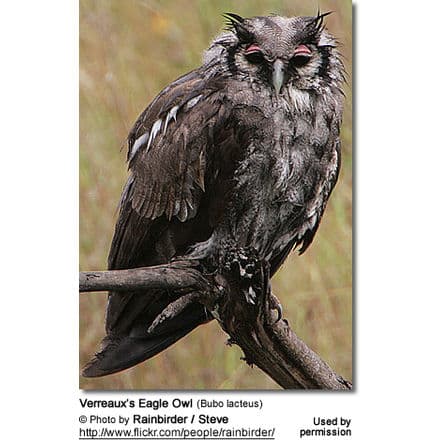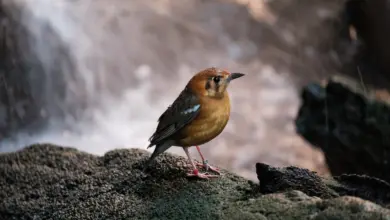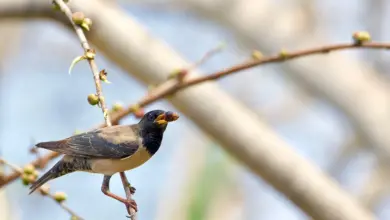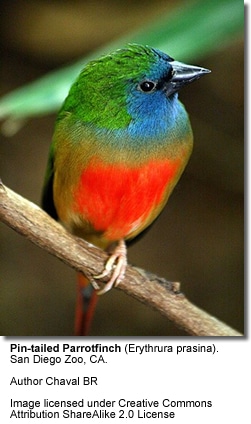Albino / Partial White / Pied / Leucistic Hummingbirds Information
Albinism in hummingbirds is caused by a rare genetic change that either prevents or reduces the formation of dark-colored pigment in feathers.

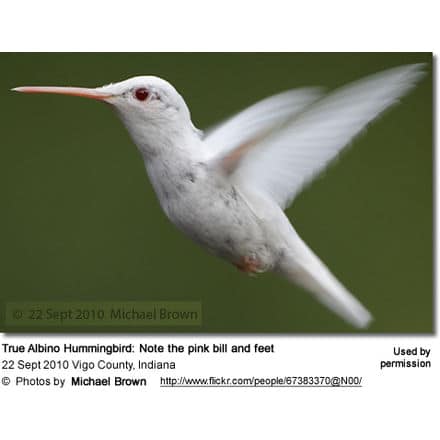
Sightings of White Hummingbirds in the United States (with locations, dates and photos)
Albinism in hummingbirds is caused by a rare genetic change that either prevents or reduces the formation of dark-colored pigment in feathers.
White hummers are extremely rare — less than a hundred sightings have been reported in the Americas; most of which involves “partial albinos” or “leucistics” and only a small percentage of the sightings involved “true albinos.”
Should you be so lucky to see a white hummingbird, get your camera out immediately and take as many pictures (or movies) as you can. Record any details about this bird (where seen, physical description and anything else that you find of interest). Please contact your local authorities for their records.
Simplified Genetics
This genetically recessive characteristic only shows up when a bird inherits the albino gene from BOTH parents. When only one parent carries this gene, the resulting young will be normal-colored, but will be genetically “split” to this genetic trait.
Should these mate with either an albino or an albino-split, a certain percentage of white young / splits will result, even though the parents themselves may not visual albinos.

Abnormally white feathers are not always due to albinism. Other possible causes are:
- Injury
- Dietary deficiencies during feather growth that interrupt the melanin deposition into the growing feather
- Disease (such as circulatory problems during feather development
- Progressive albinism is possible in aging birds (although have not been reported in hummingbirds yet)

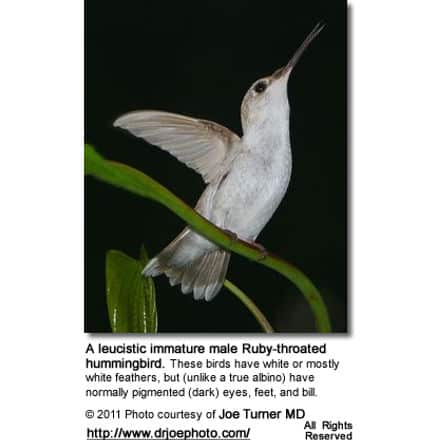
There are four degrees of albinism
- Leucistic / Partial White Hummingbirds: The more common form of albinism. Local areas of the hummingbird’s body, such as certain feathers, are lacking the pigment melanin. The color of the plumage may range from pure white, buffy, tan or greyish. Like normal-colored hummingbirds, leucistic forms have black eyes, legs and bills. Leucistic Hummingbird Photos.
- Leucism occurs in two main varieties:
- paleness, an equal reduction of melanin in all feathers
- pied, an absence of melanin in some feathers creating white patches.
- Leucism occurs in two main varieties:
- True Albino hummingbirds lacking any pigment in the skin, eyes and feathers. They have an all-white plumage. The eyes are pink or red; and the legs and feet appear whitish or pink due to the absence of black pigment, which allows red hemoglobin to show through.
Under close inspection of an albino hummingbird, it was noted that the claws and the skin of the toes appeared transparent, so much so that the blood vessels underneath the skin could be seen.
- Imperfect Albinism: Pigment is PARTIALLY inhibited in the skin, eyes or feathers, but pigment is not totally inhibited in any of them.
- Incomplete Albinism: Pigment is COMPLETELY absent from the skin, eyes or feathers (but not all three).

Albino Sightings in the USA and Canada
States / Areas Albino Hummingbirds have been reported in – sorted by location and dates. Subspecies listed if known.
(Did you see one? If so, please e-mail information (date, location, etc. and photos. THANK YOU!)

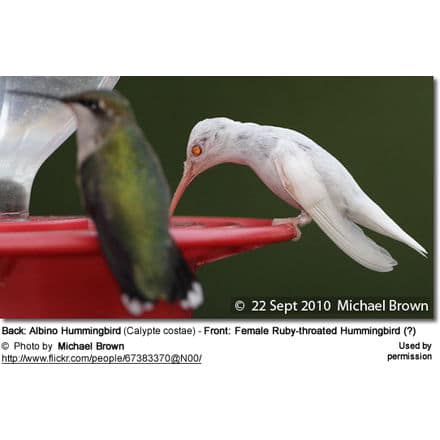
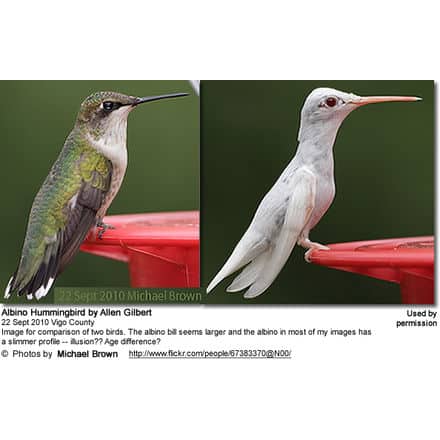
Note: The left is likely an adult female and the right an immature bird (unknown gender) that still needs to build muscles. In an adult, this poor development of muscles could be a sign of poor health ….
Slimmer Survival Chances for Albino Hummers …
Migratory hummingbirds tend to return to their favorite hummingbird feeders or flower patches year-after-year. However, it has been noted that this hasn’t been the case with albinos (true or partial) – none of which have been seen again at their previously favored feeding sites.
There are two possible scenarios that either alone, or in combination, could explain that …
Shorter lifespan … It is believed that albino hummingbirds don’t live as long as “normal”-colored hummingbirds, for the following reasons ….
- All forms of albinism are associated with vision and potentially hearing problems and albinos are, therefore, less likely to detect predators early enough to escape.
- Predators, on the other hand, are able to see albino hummingbirds far easier than the more camouflaged normal-colored hummingbirds. Even more so at night when hummingbirds go into a state of torpor (temporary or semi-hibernation). Please refer to: Hummingbirds: Interesting Facts. At this time, their white plumage is easily seen in the dark, and the albino hummingbirds are completely helpless.
- It was observed that the albino hummingbirds are more aggressively pursued / chased by their normal-colored counterparts.
- One theory is that albinos may carry a genetic defect that make them more susceptible to disease. The counter argument is that lack of pigmentation has nothing to do with immune function; nor have any physical deficiencies / abnormalities ever been associated with albinism, as known.
- Albinos are less able to cope with environmental challenges
Limited flight abilities
- Albino hummingbirds have more brittle (weaker) feathers that wear out more quickly than those of their “normal-colored” hummingbird counterparts resulting in reduced flying ability that makes migration back to their former territories difficult or impossible.
Albino hummingbirds may be less likely to attract mates ..
- The albino genetic trait may also be so rare because albinos may be less attractive to the other gender, making finding partners to mate with more difficult (but not impossible).
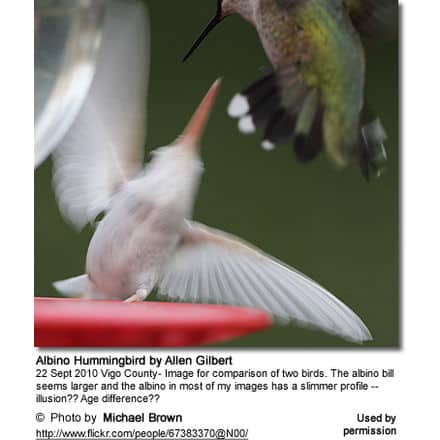
Leucistic Hummingbird Photos
Below are images of leucistic hummingbirds submitted by BeautyofBirds’ visitors. The images show the varying amounts of pigmentation occurring in this genetic mutation.
For information about these rare birds and sightings, please visit the below link.
Albino Hummingbirds – Information / Sightings
Beauty Of Birds strives to maintain accurate and up-to-date information; however, mistakes do happen. If you would like to correct or update any of the information, please contact us. THANK YOU!!!

